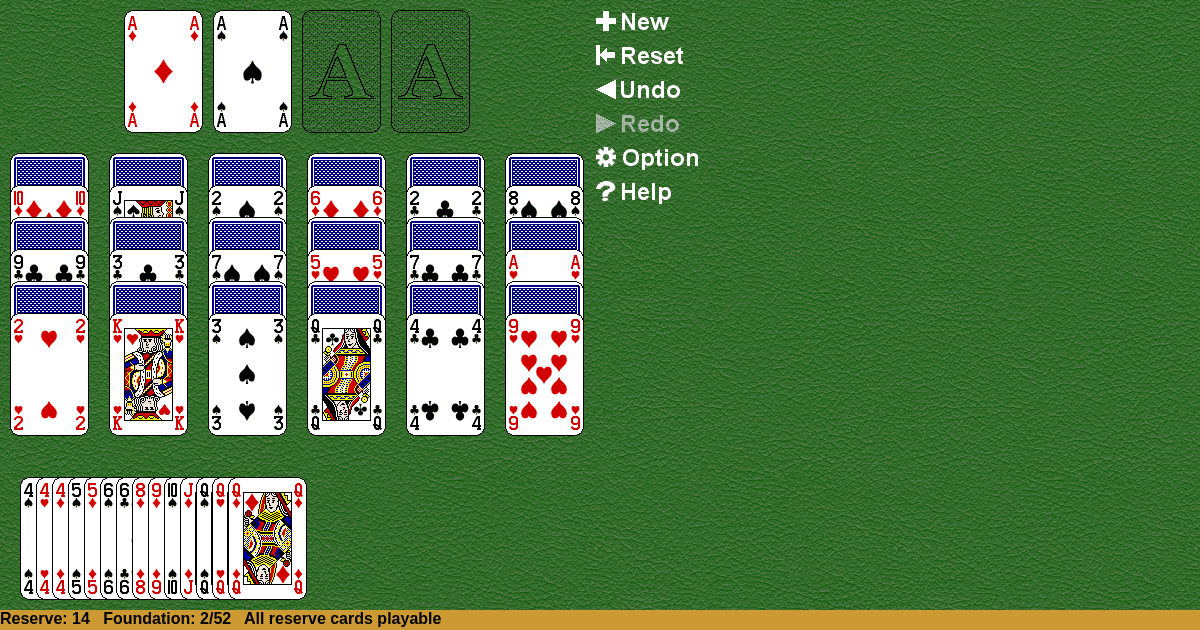Stonewall
Home |
How to play |
FAQ |
About
How to play Stonewall?
Game Objective
The primary goal of Stonewall Solitaire is to move all 52 cards from the deck onto the four foundation piles. Each foundation pile must be built in ascending suit sequence, starting with an Ace and ending with a King. The game is won when all four foundations are complete, with each containing all 13 cards of a single suit arranged from Ace through King.
Setup & Layout
Stonewall Solitaire uses a single standard 52-card deck. The game is set up with three distinct play areas:
Tableau
The tableau consists of 36 cards arranged in a 6-by-6 grid (six columns with six cards each). These cards are dealt alternately face-down and face-up, beginning with the first card face-down, the second face-up, and continuing this pattern throughout the tableau. This alternating arrangement means that in each column, cards will alternate between face-down and face-up positions. The top card of each tableau pile is available for play.
Foundations
Four foundation piles are established, one for each suit (hearts, diamonds, clubs, and spades). These piles begin empty and are built upon during gameplay.
Reserve
The remaining 16 cards (52 total cards minus 36 in the tableau) form a single reserve column. Every card in the reserve is always available for play at any time and may be moved directly to either the tableau or the foundations. Cards taken from the reserve are not replaced when moved.
Stonewall Solitaire Rules
Building on the Tableau
Cards on the tableau are built downward in alternating colors. This means a card may only be placed on top of another card if it is one rank lower and of the opposite color. For example, a 10 of hearts (red) can be placed on a Jack of clubs (black), or a 5 of spades (black) can be placed on a 6 of diamonds (red).
Moving Cards and Sequences
A single card or an entire packed sequence (a group of cards already built in proper sequence) may be moved from one tableau pile to another tableau pile, provided the move follows the alternating color and descending rank rules. When a sequence is moved, all cards in that sequence move together as a unit.
Playing to the Foundations
Only the top card of each tableau pile is available for play on the foundations. Cards from the reserve, however, are always available for play on the foundations at any time. Cards are built on the foundations in ascending suit sequence, beginning with an Ace and proceeding through King.
Filling Empty Spaces
When a tableau pile becomes empty, any available card or packed sequence may be placed in that space to fill it. An available card includes any card from the reserve or the top card of any other tableau pile.
Face-Down Cards
Cards that are dealt face-down in the tableau are turned face-up once they become available for play (that is, once all cards covering them have been removed).
Gameplay
During each turn, a player may perform any of the following actions:
- Move the top card of a tableau pile to another tableau pile, provided the move follows the alternating color and descending rank rules.
- Move a packed sequence from one tableau pile to another tableau pile, following the same building rules.
- Move the top card of a tableau pile to a foundation pile, if it is an Ace or if it continues the suit sequence on that foundation.
- Move any card from the reserve to a tableau pile or foundation pile, following the applicable building rules.
- Fill an empty tableau space with any available card or sequence from another tableau pile or from the reserve.
The game continues with the player making legal moves until either all cards have been moved to the foundations (a win) or no more legal moves are available (a loss). Unlike some solitaire variants, Stonewall Solitaire does not include a stock pile or redeal mechanism.
Winning & Losing Conditions
Winning
The game is won when all 52 cards have been successfully moved to the four foundation piles, with each foundation containing all 13 cards of a single suit arranged in ascending order from Ace to King.
Losing
The game is lost when no more legal moves are available and the foundations are not yet complete. This occurs when the player cannot move any tableau card to another tableau pile, cannot move any tableau or reserve card to a foundation pile, and cannot fill any empty tableau spaces in a way that would eventually lead to a winning position. Stonewall Solitaire is considered a difficult variant with a low win rate, as the game contains a large element of luck dependent on the initial shuffle and card arrangement.
Special Rules & Edge Cases
Reserve Card Availability
All cards in the reserve are permanently available for play at any time throughout the game. Unlike tableau cards, reserve cards do not need to be uncovered or revealed; they remain accessible from the moment the game begins.
No Redeal
Stonewall Solitaire does not include a stock pile or redeal mechanism. Once the initial 52 cards are dealt to the tableau and reserve, no additional cards are introduced into play. All moves must be made using only the cards already in play.
Sequence Movement
When moving a sequence of cards from one tableau pile to another, the entire sequence moves as a single unit. The sequence must maintain its internal order and must be placed on a card that is one rank higher and of the opposite color from the bottom card of the sequence being moved.
Empty Tableau Spaces
Empty tableau spaces created by moving all cards from a pile are valuable strategic opportunities. These spaces may be filled with any available card or sequence, providing flexibility in unblocking face-down cards or rearranging the tableau to access cards needed for the foundations.




























































